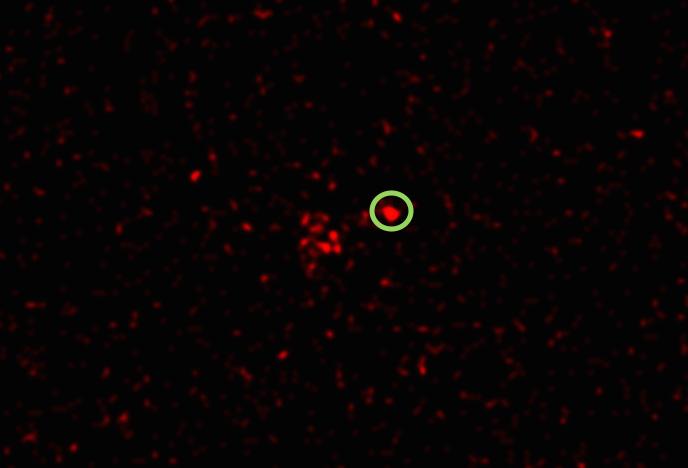UChicago scientists detect first X-rays from mystery supernovas

An image showing X-rays detected from the supernova 2012ca (inside the circle). Image has been smoothed and colorized. Credit: Vikram Dwarkadas/Chandra X-ray Observatory
Exploding stars lit the way for our understanding of the universe, but researchers are still in the dark about many of their features.
A team of scientists, including scholars from the University of Chicago, appear to have found the first X-rays coming from type Ia supernovae. Their findings are published online Aug. 23 in the Monthly Notices of the Royal Astronomical Society.
Astronomers are fond of type Ia supernovas, created when a white dwarf star in a two-star system undergoes a thermonuclear explosion, because they burn at a specific brightness. This allows scientists to calculate how far away they are from Earth, and thus to map distances in the universe. But a few years ago, scientists began to find type Ia supernovas with a strange optical signature that suggested they carried a very dense cloak of circumstellar material surrounding them.
Such dense material is normally only seen from a different type of supernova called type II, and is created when massive stars start to lose mass. The ejected mass collects around the star; then, when the star collapses, the explosion sends a shockwave hurtling at supersonic speeds into this dense material, producing a shower of X-rays. Thus we regularly see X-rays from type II supernovas, but they have never been seen from type Ia supernovas.
When the UChicago-led team studied the supernova 2012ca, recorded by the Chandra X-ray Observatory, however, they detected X-ray photons coming from the scene.
“Although other type Ia's with circumstellar material were thought to have similarly high densities based on their optical spectra, we have never before detected them with X-rays,” said study co-author Vikram Dwarkadas, research associate professor in the Department of Astronomy and Astrophysics.
The amounts of X-rays they found were small–they counted 33 photons in the first observation a year and a half after the supernova exploded, and ten in another about 200 days later–but present.
“This certainly appears to be a Ia supernova with substantial circumstellar material, and it looks as though it's very dense,” he said. “What we saw suggests a density about a million times higher what we thought was the maximum around Ia's.”
It's thought that white dwarfs don't lose mass before they explode. The usual explanation for the circumstellar material is that it would have come from a companion star in the system, but the amount of mass suggested by this measurement was very large, Dwarkadas said–far larger than one could expect from most companion stars. “Even the most massive stars do not have such high mass-loss rates on a regular basis,” he said. “This once again raises the question of how exactly these strange supernovas form.”
“If it's truly a Ia, that's a very interesting development because we have no idea why it would have so much circumstellar material around it,” he said.
“It is surprising what you can learn from so few photons,” said lead author and Caltech graduate student Chris Bochenek; his work on the study formed his undergraduate thesis at UChicago. “With only tens of them, we were able to infer that the dense gas around the supernova is likely clumpy or in a disk.”
More studies to look for X-rays, and even radio waves coming off these anomalies, could open a new window to understanding such supernovas and how they form, the authors said.
Media Contact
All latest news from the category: Physics and Astronomy
This area deals with the fundamental laws and building blocks of nature and how they interact, the properties and the behavior of matter, and research into space and time and their structures.
innovations-report provides in-depth reports and articles on subjects such as astrophysics, laser technologies, nuclear, quantum, particle and solid-state physics, nanotechnologies, planetary research and findings (Mars, Venus) and developments related to the Hubble Telescope.
Newest articles

High-energy-density aqueous battery based on halogen multi-electron transfer
Traditional non-aqueous lithium-ion batteries have a high energy density, but their safety is compromised due to the flammable organic electrolytes they utilize. Aqueous batteries use water as the solvent for…

First-ever combined heart pump and pig kidney transplant
…gives new hope to patient with terminal illness. Surgeons at NYU Langone Health performed the first-ever combined mechanical heart pump and gene-edited pig kidney transplant surgery in a 54-year-old woman…

Biophysics: Testing how well biomarkers work
LMU researchers have developed a method to determine how reliably target proteins can be labeled using super-resolution fluorescence microscopy. Modern microscopy techniques make it possible to examine the inner workings…





















